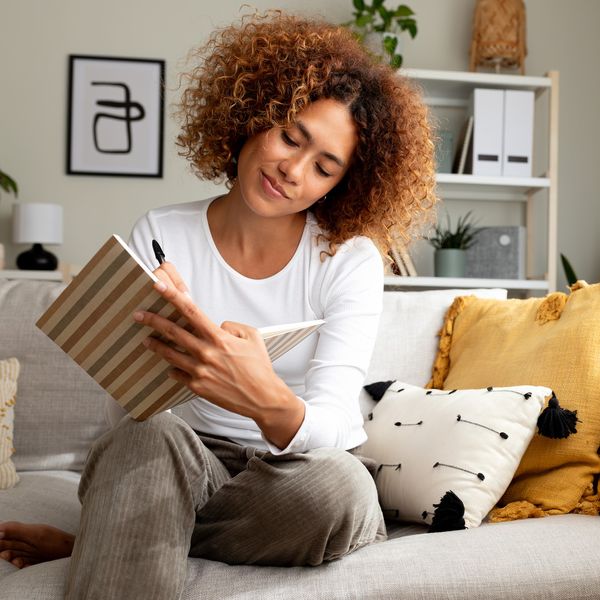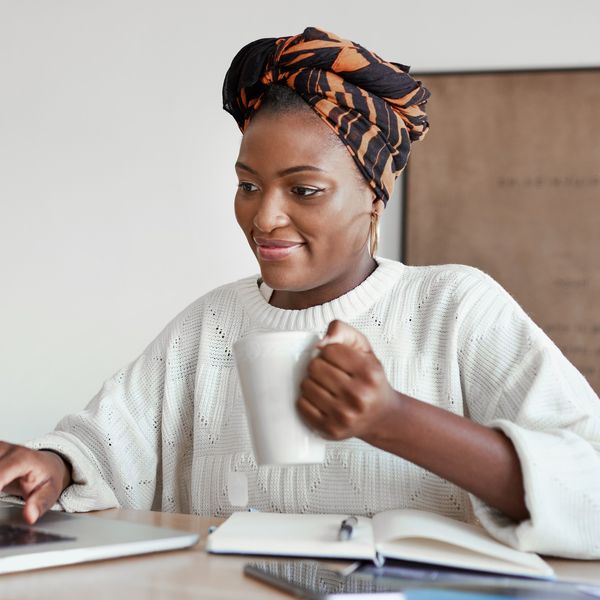
Black In A Corporate Workplace? Here's How To Drive Racial Change At Work
More than a month has passed since George Floyd's death, and perhaps it's just me, but it seems like the energy behind supporting Black businesses and standing with Black people has waned a little. The company statements have been made and filed, the black squares have disappeared from Instagram, and the protests and those who support them seem to be out of the news cycle.
Particularly for those of us who continue to work in Corporate America, the environment can be especially difficult because after a few weeks of advocacy for change, it appears that everyone in the office has moved past "Black Lives Matter" and addressing inequality and discrimination in the workplace in favor of returning to "normal". Unfortunately, there is no returning to normal for us. So, what can we do to help keep the conversation going in a positive way to create the workplace transformation we desire to see?
Here are some ideas to help your organization keep that same energy:
Create conversations where they may not yet exist.

Shutterstock.
If you have staff or all-hands meetings, consider introducing diversity and inclusion topics into the agenda to facilitate open discussions. Many of our non-Black counterparts may be unaware of the privilege they possess in the workplace and the injustices that Black people face at work. They may not fully understand that racism is displayed not only overt action, but by covert behaviors and the microaggressions we experience. Pro Tip: Consider using interactive exercises to make concepts more concrete and relevant.
Leverage leadership connections.
Do you have a mentor, sponsor, or advocate who is also passionate about changing the racial landscape in your organization? How can you leverage their platform and/or influence to help engage other members of the leadership team? Share your perspective with your connections and get their feedback on methods to create impact and revise long-standing policies. When leaders show that this issue is not only important to them, but that they are willing to take the necessary steps to change, the employees throughout the company are much more likely to take it seriously.
Utilize employee resource groups (ERGs).

Shutterstock.
Typically these internal collectives are focused on diverse segments of the employee population that face discrimination, prejudice, or exclusion in some way, i.e. women, underrepresented minorities, and the LGBTQ community. Engaging these groups can be another avenue to penetrate the organization and bring additional attention to the issues facing Black employees. ERGs usually have executive or leadership sponsors/contacts who may be able to use their voices to keep these issues at the forefront to be addressed.
Advocate for a more diverse workforce.
Hear me out. Part of the reason why the response from many companies on Black Lives Matter was not as impactful or as long-lasting as we would have hoped is because the diversity of the employee population does not support the message. It's hard for people to believe you care about the equality of Black people and that you want to see them succeed when: 1) no one in a mid-level to senior-level management position is Black, 2) no one in the C-Suite is Black, and 3) none of the top-tier management roles have succession plans that include Black people. When you have no one to look up to in your company that looks like you, it truly feels like it's impossible for you to succeed.
Outside of leveraging connections and support groups you already have, this is an opportunity for you to bring this issue head-on to those making the hiring decisions. Whether it's a direct letter to your CEO and executive leadership team, a frank conversation with your human resources department on hiring practices, organizing 1:1 or intimate meetings with the VP or Director of your department and other Black employees, let your voice be heard clearly. A good friend of mine prepared a full PowerPoint presentation for his Vice President to share the rather sobering figures of the lack of Black employees in leadership in his department, which in turn sparked a deeper dive into hiring practices and job placement of Black employees once hired. While these conversations are uncomfortable, these can prove to be the catalyst required for change.
Believe me, I get it. Being Black in corporate workspaces, many times you feel undervalued and unseen, and even more so right now. But while racism is not our problem to fix, we can help drive the solutions. We cannot wait on others to do the work. We must be the change we want to see.
Need more career talk like this in your life? Join the xoTribe members community to connect, vibe and share your wins with the tribe.
Featured image by Shutterstock.
- Speaking Up At Work As A Black Woman - xoNecole: Women's ... ›
- Beauty & The Black Dollar: Why Our Collective Power Is Key To The ... ›
- Pass The CROWN: Why This Exec Is On A Mission To End Black ... ›
- The JOY Collective Execs Talk Fighting Hair Discrimination And ... ›
- Kamala Harris Thinks Women Not Returning To The Workforce Is A Crisis – But Is It? - xoNecole: Women's Interest, Love, Wellness, Beauty ›
This article is sponsored by Hulu.
UnPrisonedhas returned for its highly anticipated second season, delving deeper into the complex dynamics of the Alexander family.
The series premiere comes a year after its debut season garnered rave reviews from fans and critics and earned record-breaking ratings for Hulu's Onyx Collective brand. UnPrisoned's success can be attributed to its raw, relatable themes and comedic appeal.
Inspired by creator Tracy McMillan's life, the show follows Paige (Kerry Washington), a therapist and single mother whose life takes an unexpected turn when her father, Edwin (Delroy Lindo) --who was released from prison-- moves in with her and her teenage son, Finn (Faly Rakotohavana).
Throughout UnPrisoned's first season, viewers witnessed how Edwin's incarceration deeply affected Paige's life and relationships. In the series, Paige unpacks her trauma through interactions with her inner child and her online followers. Meanwhile, Edwin is overcoming specific struggles with his own past that led to his life of crime, including a dysfunctional upbringing and his mother's arrest. As the Alexanders attempt to reconcile, new challenges arise.
This new season promises to further explore their unconventional family dynamic. Here are several compelling reasons why season two of UnPrisoned should be on everyone's watchlist.
The Alexander Family Life Is Still In Shambles
UnPrisoned's second season resumes where the series left off, with Paige grappling with the fallout from her troubled therapy practice and Edwin navigating life independently after moving out. Meanwhile, Finn faces his own challenges. The teenager is battling anxiety and seeking information about his father—a topic Paige avoids discussing.
The Alexander Family Are Attending Therapy To Resolve Their Underlying Issues
Amid the chaos in their lives, the Alexander family decides to mend their bond by confronting their past traumas. They seek professional help and attend therapy sessions with a “family radical healing coach,” played by John Stamos, a new cast member. This collective effort aims to unravel the complexities of their shared history and strengthen their relationships.
The process of unraveling each character's internal conflicts and their potential impact on future relationships may clash with Paige's textbook therapy approach. While Paige is used to being in the therapist's seat in both career and family, this forces her into the unfamiliar role of a patient during therapy sessions. This shift would compel her to look in the mirror and try a radically different approach.
The Alexander Family Learned A Big Lesson During A Therapy Session
In therapy, the Alexanders are tasked with addressing their individual traumas to salvage their remaining relationships. One of the family therapist’s eccentric suggestions was an exercise involving a family wrestling match. During this session, Paige faces tough questions about her refusal to share information about Finn's father.
While it's unclear whether this scene is reality or fantasy, the image of the family duking it out in the ring certainly makes for hilarious yet compelling television.
Paige Tries Dating Again Following Failed Relationships
Amid her life's chaos, Paige decides to step back into the dating field. However, her many attempts have left her with mixed results. The dating apps have turned out to be a fail, and an outing with her ex Mal (Marque Richardson), who is also her father's parole officer, doesn’t go quite as expected after he brings an unexpected guest – his new girlfriend.
The situation takes an awkward turn when Mal's new partner learns why the former couple split, partly due to Paige's self-sabotage.
UnPrisoned Is A Perfect Balance Of Comedy And Drama
As a dramedy, UnPrisoned takes a comedic approach to its heavy subjects. The show takes us on a ride with Paige's dating misadventures and navigating a friendship with her ex.
Other lighthearted moments include Edwin's attempts at CPR based on online videos and, of course, the antics of the Alexander family's unconventional new healing coach.
The second season of UnPrisoned is now available on Hulu.
UnPrisoned | Season 2 Trailer | Hulu
Feature image courtesy
Blair Underwood Initially Turned Down 'Sex And The City' Because 'It Was About How Samantha Was Fascinated By Dating A Black Man’
Actor and heartthrob Blair Underwood is opening up about why he turned down Sex and the City the first time he was offered a role. Many fans of the HBO series may recall Blair's time on the show in which his character was dating Miranda (Cynthia Nixon). However, he was previously offered another role where his character would date Samantha (Kim Cattrall).
During his interview with AV Club, the Set It Off star revealed that he was uncomfortable with the initial offer due to the character's fascination with him being a Black man.
“I actually did say ‘no’ the first time,” he said. “The first time they had offered the role, to be honest with you, it was about how Samantha was fascinated by dating a Black man and wanted to know if, uh, all of the rumors were true about our anatomy! And I said, ‘Listen, I’m honored, thank you, but I just don’t want to play a character based on race, on curiosity about a Black man.'”
But that didn't stop them from reaching out again. This time he was offered to play Dr. Robert Leeds, the love interest to Miranda and he decided to go for it. "So they were nice enough to call about a year later, and I said, 'Well, is it gonna be about race?' And they said, 'No, no, no, we’re not even gonna mention race!' And I think it really did only come up maybe once," he recalled.
"It did five episodes, and I think Samantha mentioned it once, saying something about 'a Black doctor' that Miranda was dating. And that’s really been a consistent thing in my career: not wanting to be boxed as 'the Black guy.'
"I’ve had that conversation with many producers along the way, and they were so great. They said, 'No, he’s just a doctor who Miranda meets in the elevator, and they have a nice little fling.' And it was amazing."
Blair has had a wide-ranging career playing everything from a lawyer on L.A. Law to playing Madame CJ Walker's husband on Self Made: Inspired by the Life of Madame CJ Walker. And during his interview, he revealed another role that he initially turned down, Set It Off. The movie, which is considered a classic in Black culture, stars Queen Latifah, Jada Pinkett Smith, Vivica A. Fox, and Kimberly Elise. Blair's character, Keith, played a banker and love interest to Jada's character, Stony.
He explained why he said no at first and eventually accepted the offer. "I had initially said “no” to that. Because I was playing this historic, iconic African-American historical figure in Jackie Robinson, and the time, y’know, there was Boyz N The Hood, and Menace II Society was out there, and I’d finished playing this noble Negro… [Laughs]," he said.
"And I’m reading the script, and there’s a scene where Jada Pinkett’s character—Jada Pinkett-Smith now—was going to sell her body so she could make some money to send her brother to college. And I remember, honestly, I threw the script across the room. I was, like, “I don’t want to do this. I want to do something uplifting for the Black culture and Black characters, and I don’t know if I want to see this.”
After a conversation with the movie's director F. Gary Gray and the actor's manager encouraging him to finish reading the script, Blair had a change of heart. What he first thought about the movie turned out to be totally different.
"So I finished the script, and I saw that the character they were asking me to play was really the love story in the midst of all of this turmoil of all of these characters, the four ladies: Queen Latifah, Vivica Fox, Kimberly Elise, and Jada," he explained.
"It was so well-written, it was such a great platform for them. And to be able to play the love story and the storyline that gave Jada’s character a leg up and a way out of this world, something to hope for, to wish for, someone to love her… I said, 'You know what? I’d like to be a part of that.'
"And I’m so glad I did, because that film resonates to this day. People all the time come up to me and say that they love that movie. So I’m glad that I did it."









